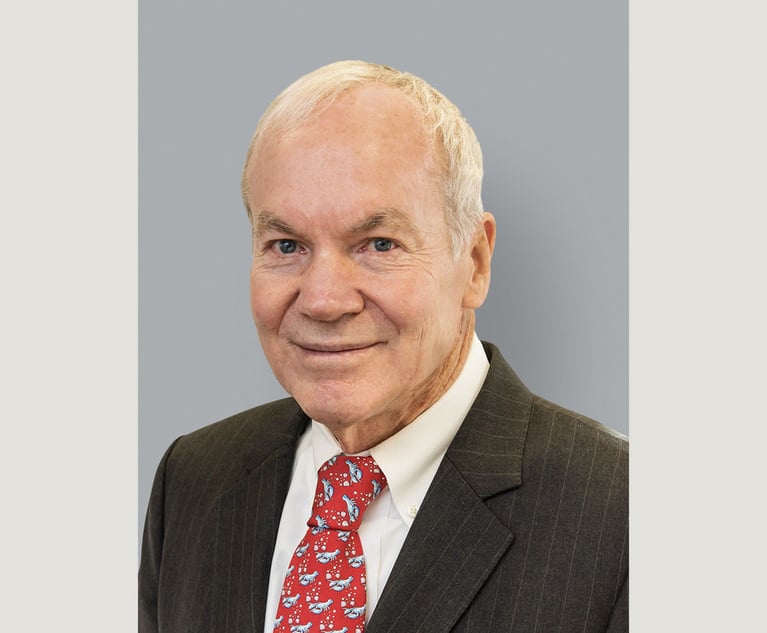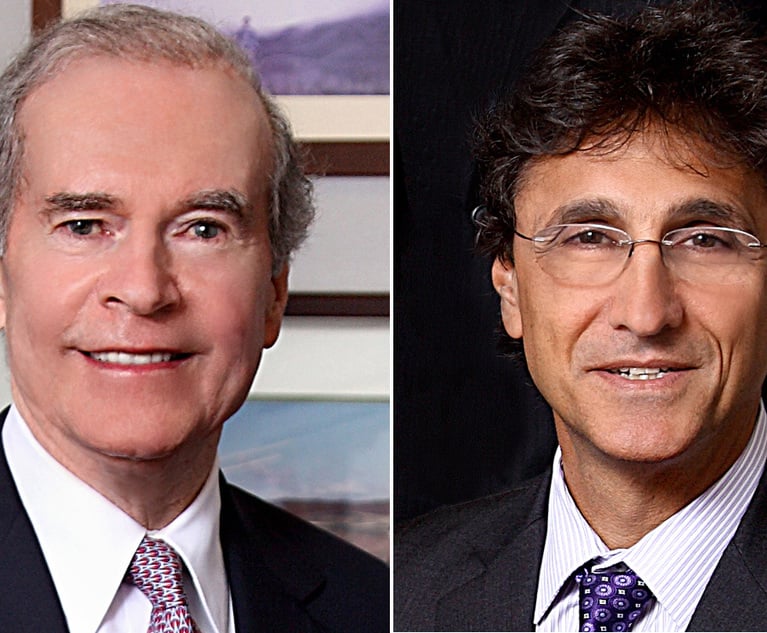 (L-R)John Lyddane of Dorf & Nelson. Courtesy photo
(L-R)John Lyddane of Dorf & Nelson. Courtesy photo Whose Records Are Privileged in Medical Malpractice Cases?
The statute provides that unless the patient waives the privilege, the provider shall not be allowed to disclose any information acquired in attending to a patient in a professional capacity, which was necessary to enable the practitioner to act in that capacity.
May 17, 2023 at 11:32 AM
8 minute read
The physician-patient privilege did not exist at common law and is a creature of statute. New York was the first state to enact the privilege in 1828, and it is currently codified in CPLR Sec. 4504. Although there are exceptions relating to alcohol-related driving offenses, child protection, and communicable diseases, the basic premise is that the legislature has determined that uninhibited communication by patient to physician produces overall better medical advice and treatment. [See Dillenbeck v. Hess, 73 NY2d 278 (1989).] The statute provides that unless the patient waives the privilege, the provider shall not be allowed to disclose any information acquired in attending to a patient in a professional capacity, which was necessary to enable the practitioner to act in that capacity. CPLR Sec. 4504 (a). Over time the courts have had to apply the statute to a variety of situations more complex than the isolated relationship between a single patient and physician, yielding practical guidance to court and counsel for the application of the statute in discovery and at trial.
The protection of physician-patient communications being balanced against the primary truth-seeking function of the courts has required close examination of what constitutes a communication, whose communication is privileged, and a variety of issues related to waiver. As seen in Williams v. Roosevelt Hospital, 66 NY2d 391 (1985), the Court of Appeals has drawn a sharp distinction between communications that are privileged, as opposed to factual observations regarding nonparty family members that are not. The modern approach is to require the party asserting the privilege to show the existence of circumstances justifying its recognition, and to apply the privilege restrictively rather than expansively. [See Bloodgood v. Lynch, 293 NY 308 (1944).]
This content has been archived. It is available through our partners, LexisNexis® and Bloomberg Law.
To view this content, please continue to their sites.
Not a Lexis Subscriber?
Subscribe Now
Not a Bloomberg Law Subscriber?
Subscribe Now
NOT FOR REPRINT
© 2025 ALM Global, LLC, All Rights Reserved. Request academic re-use from www.copyright.com. All other uses, submit a request to [email protected]. For more information visit Asset & Logo Licensing.
You Might Like
View All



CPLR Article 16 Apportionment And Dismissed Defendants Medical Malpractice
14 minute readTrending Stories
- 1States Accuse Trump of Thwarting Court's Funding Restoration Order
- 2Microsoft Becomes Latest Tech Company to Face Claims of Stealing Marketing Commissions From Influencers
- 3Coral Gables Attorney Busted for Stalking Lawyer
- 4Trump's DOJ Delays Releasing Jan. 6 FBI Agents List Under Consent Order
- 5Securities Report Says That 2024 Settlements Passed a Total of $5.2B
Who Got The Work
J. Brugh Lower of Gibbons has entered an appearance for industrial equipment supplier Devco Corporation in a pending trademark infringement lawsuit. The suit, accusing the defendant of selling knock-off Graco products, was filed Dec. 18 in New Jersey District Court by Rivkin Radler on behalf of Graco Inc. and Graco Minnesota. The case, assigned to U.S. District Judge Zahid N. Quraishi, is 3:24-cv-11294, Graco Inc. et al v. Devco Corporation.
Who Got The Work
Rebecca Maller-Stein and Kent A. Yalowitz of Arnold & Porter Kaye Scholer have entered their appearances for Hanaco Venture Capital and its executives, Lior Prosor and David Frankel, in a pending securities lawsuit. The action, filed on Dec. 24 in New York Southern District Court by Zell, Aron & Co. on behalf of Goldeneye Advisors, accuses the defendants of negligently and fraudulently managing the plaintiff's $1 million investment. The case, assigned to U.S. District Judge Vernon S. Broderick, is 1:24-cv-09918, Goldeneye Advisors, LLC v. Hanaco Venture Capital, Ltd. et al.
Who Got The Work
Attorneys from A&O Shearman has stepped in as defense counsel for Toronto-Dominion Bank and other defendants in a pending securities class action. The suit, filed Dec. 11 in New York Southern District Court by Bleichmar Fonti & Auld, accuses the defendants of concealing the bank's 'pervasive' deficiencies in regards to its compliance with the Bank Secrecy Act and the quality of its anti-money laundering controls. The case, assigned to U.S. District Judge Arun Subramanian, is 1:24-cv-09445, Gonzalez v. The Toronto-Dominion Bank et al.
Who Got The Work
Crown Castle International, a Pennsylvania company providing shared communications infrastructure, has turned to Luke D. Wolf of Gordon Rees Scully Mansukhani to fend off a pending breach-of-contract lawsuit. The court action, filed Nov. 25 in Michigan Eastern District Court by Hooper Hathaway PC on behalf of The Town Residences LLC, accuses Crown Castle of failing to transfer approximately $30,000 in utility payments from T-Mobile in breach of a roof-top lease and assignment agreement. The case, assigned to U.S. District Judge Susan K. Declercq, is 2:24-cv-13131, The Town Residences LLC v. T-Mobile US, Inc. et al.
Who Got The Work
Wilfred P. Coronato and Daniel M. Schwartz of McCarter & English have stepped in as defense counsel to Electrolux Home Products Inc. in a pending product liability lawsuit. The court action, filed Nov. 26 in New York Eastern District Court by Poulos Lopiccolo PC and Nagel Rice LLP on behalf of David Stern, alleges that the defendant's refrigerators’ drawers and shelving repeatedly break and fall apart within months after purchase. The case, assigned to U.S. District Judge Joan M. Azrack, is 2:24-cv-08204, Stern v. Electrolux Home Products, Inc.
Featured Firms
Law Offices of Gary Martin Hays & Associates, P.C.
(470) 294-1674
Law Offices of Mark E. Salomone
(857) 444-6468
Smith & Hassler
(713) 739-1250






